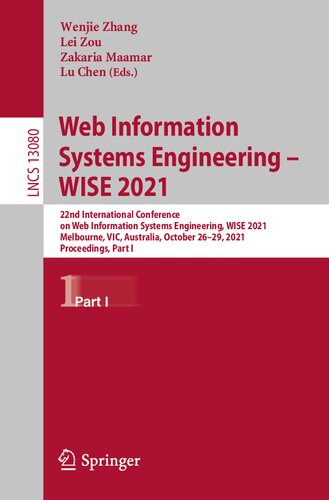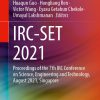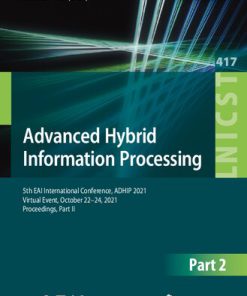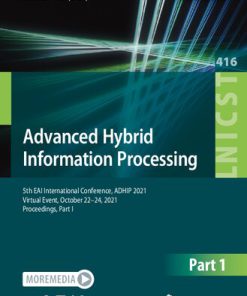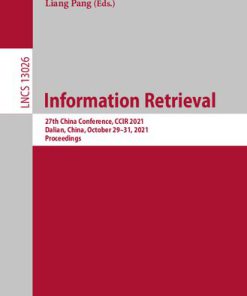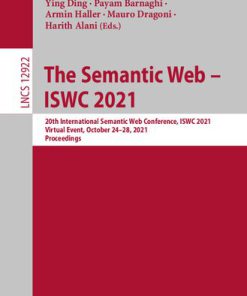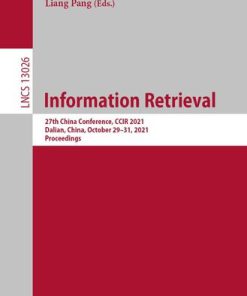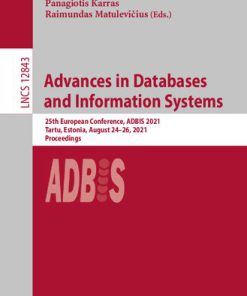Web Information Systems Engineering – WISE 2021: 22nd International Conference on Web Information Systems Engineering, WISE 2021, Melbourne, VIC, Australia, October 26-29, 2021 Proceedings, Part I by Wenjie Zhang9783030908881 3030908887
$50.00 Original price was: $50.00.$25.00Current price is: $25.00.
Web Information Systems Engineering – WISE 2021: 22nd International Conference on Web Information Systems Engineering, WISE 2021, Melbourne, VIC, Australia, October 26-29, 2021 Proceedings, Part I Wenjie Zhang – Ebook Instant Download/Delivery ISBN(s): 9783030908874, 3030908879, 9783030908881, 3030908887
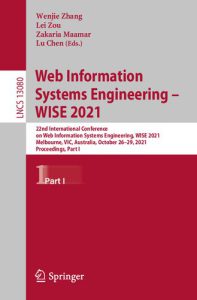
Product details:
- ISBN 10: 3030908887
- ISBN 13: 9783030908881
- Author: Wenjie Zhang
This two-volume set constitutes the proceedings of the 22nd International Conference on Web Information Systems Engineering, WISE 2021, held in Melbourne, VIC, Australia, in October 2021. The 55 full, 29 short and 5 demo papers, plus 2 tutorials were carefully reviewed and selected from 229 submissions.
Table contents:
BlockChain and Crowdsourcing
Crowdsourcing Software Vulnerability Discovery: Models, Dimensions, and Directions
Expertise-Aware Crowdsourcing Taxonomy Enrichment
Transaction Confirmation Time Estimation in the Bitcoin Blockchain
Automatic Malicious Worker Detection in Crowdsourced Paraphrases
A Blockchain-Based Approach for Trust Management in Collaborative Business Processes
Database System and Workflow
Exploiting Unblocking Checkpoint for Fault-Tolerance in Pregel-Like Systems
A Low-Latency Metadata Service for Geo-Distributed File Systems
XTuning: Expert Database Tuning System Based on Reinforcement Learning
CELA: An Accurate Learned Cardinality Estimator with Strong Generalization Ability and Dimensional Adaptability
Cost-Based Lightweight Storage Automatic Decision for In-Database Machine Learning
Data Mining and Applications
NP-PROV: Neural Processes with Position-Relevant-Only Variances
A Minority Class Boosted Framework for Adaptive Access Control Decision-Making
Recognizing Hand Gesture in Still Infrared Images by CapsNet
Vertical Federated Principal Component Analysis on Feature-Wise Distributed Data
Anchoring-and-Adjustment to Improve the Quality of Significant Features
Data Mining Based Artificial Intelligent Technique for Identifying Abnormalities from Brain Signal Data
Where Should I Go? A Deep Learning Approach to Personalize Type-Based Facet Ranking for POI Suggestion
Modeling Without Sharing Privacy: Federated Neural Machine Translation
Knowledge Graph and Entity Linking
Encoding the Meaning Triangle (Object, Entity, and Concept) as the Semantic Foundation for Entity Alignment
Incorporating Network Structure with Node Information for Semi-supervised Anomaly Detection on Attributed Graphs
OntoSP: Ontology-Based Semantic-Aware Partitioning on RDF Graphs
Optimal Subgraph Matching Queries over Distributed Knowledge Graphs Based on Partial Evaluation
Enhancing both Local and Global Entity Linking Models with Attention
HyperJOIE: Two-View Hyperbolic Knowledge Graph Embedding with Entities and Concepts Jointly
IOPE: Interactive Ontology Population and Enrichment Guided by Ontological Constraints
Graph Neural Network
Controversy Detection: A Text and Graph Neural Network Based Approach
GMGCN: Gated Memory Graph Convolutional Network for Passenger Demand Prediction
Event Detection in Social Media via Graph Neural Network
Knowledge-Guided Fraud Detection Using Semi-supervised Graph Neural Network
MSSF-GCN: Multi-scale Structural and Semantic Information Fusion Graph Convolutional Network for Controversy Detection
A Syntax-Aware Encoder for Authorship Attribution
Graph Attentive Leaping Connection Network for Chinese Short Text Semantic Classification
Graph Query
Graph Ordering: Towards the Optimal by Learning
Fast Approximate All Pairwise CoSimRanks via Random Projection
Critical Nodes Identification in Large Networks: An Inclination-Based Model
LPMA – An Efficient Data Structure for Dynamic Graph on GPUs
Updating Maximal -Cliques of a Temporal Network Efficiently
Social Network
Web of Students: Class-Level Friendship Network Discovery from Educational Big Data
Event Cube for Suicidal Event Analysis: A Case Study
Cross-modal Attention Network with Orthogonal Latent Memory for Rumor Detection
OMT: An Operate-Based Approach for Modelling Multi-topic Influence Diffusion in Online Social Networks
Modeling User Profiles Through Multiple Types of User Interaction Behaviors
HACK: A Hierarchical Model for Fake News Detection
Spatial and Temporal Data Analysis
An Efficient Approach for Spatial Trajectory Anonymization
Developing a Deep Learning Based Approach for Anomalies Detection from EEG Data
Dynamic Transit Flow Graph Prediction in Spatial-Temporal Network
Disatra: A Real-Time Distributed Abstract Trajectory Clustering
Extra-Budget Aware Task Assignment in Spatial Crowdsourcing
Expert Recommendations with Temporal Dynamics of User Interest in CQA
People also search:
web information systems engineering
engineering information systems
computer and information science and engineering (cise)
computer information engineering
computer information systems engineering
You may also like…
Computers - Computer Science
Computers - Computer Science
Computers - Computer Science
Computers - Computer Science
Computers - Computer Science
Education Studies & Teaching - Studying & Test Preparation

